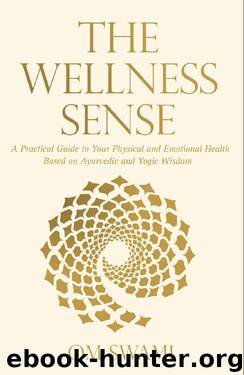The Wellness Sense by Om Swami

Author:Om Swami [Swami, Om]
Language: eng
Format: epub
ISBN: 9780994002730
Published: 2014-12-02T23:00:00+00:00
10
Life Cycle of a Disease
‘Disease then is a force and not matter.’
– Sushruta.
What is a disease, really? In the Oxford Dictionary of English, ‘disease’ is defined as: ‘a disorder of structure or function in a human, animal, or plant, especially one that produces specific symptoms or that affects a specific location and is not simply a direct result of physical injury’.
Complete as that definition sounds, it is not how Ayurvedic or yogic scriptures look at it. A disease is not merely a structural or a functional disorder; it could easily be an emotional one also. Beyond the symptom-driven definitions in contemporary medical science, a disease is what disrupts your equilibrium, that is, your physical, mental, emotional and spiritual balance.
Self-deprecation is a disease, as is pride; anger is a disease, as is envy. Anything that throws you off-balance, physically or mentally, is a disease. It is when both body and mind are in balance – with each other and within themselves – that we can truly say one is healthy, that one is disease-free.
The great physician-sage, Sushruta, is asked in Sushruta Samhita, a major Ayurvedic text: ‘What is a disease? What is it in a human that actually falls sick? What do we actually treat with medicines? Is it the body or the mind?’
Sushruta speaks: ‘Anything that afflicts the inner man is disease; and that disease has its primary seat in the inner spring of vitality from which it flows out to the surface, the external body.’
The inner man is called the self or purusha in yogic texts. Pura means city. This body is a city of nine gates (the nine orifices) and the one that has the stronghold of this body is called purusha. When this purusha leaves the body, the person is pronounced dead. The atoms are there, the molecules are there, but there is no breathing, no movement, no emotions or feelings and no consciousness. Biologically, the body is intact, but it has lost the ability to maintain its individual nature within nature. It must now decompose and give back the five elements to nature. Even mentally or emotionally, when we lose our sense of individuality, we become listless, and life seems pointless. It is to retain this individuality that the powerful want more power, and the rich want more riches. The sense of individuality that comes from writing a fine poem, or winning a chess game, or finishing a painting, or beating a record, is the primary driving force behind the evolution and growth of our race.
The vital life force that gives us individuality – that gives us the ability to sustain ourselves as a separate entity while being a part of nature – is called the inner being or purusha. This is our centre of vitality, the control centre.
Sushruta Samhita further states that diseases spring from the afflictions of the inner man and then out to the body. I quote:*
In man, as in everything else in the universe, the direction of the inherent force is from the centre to the circumference.
Download
This site does not store any files on its server. We only index and link to content provided by other sites. Please contact the content providers to delete copyright contents if any and email us, we'll remove relevant links or contents immediately.
Inner Engineering: A Yogi's Guide to Joy by Sadhguru(6694)
The Power of Now: A Guide to Spiritual Enlightenment by Eckhart Tolle(5580)
Fear by Osho(4642)
Ikigai by Héctor García & Francesc Miralles(4097)
The Art of Happiness by The Dalai Lama(4047)
The Ultimate Bodybuilding Cookbook by Kendall Lou Schmidt(3871)
Yoga Therapy by Mark Stephens(3684)
The Little Book of Hygge by Meik Wiking(3574)
The Healing Self by Deepak Chopra(3448)
Why Buddhism is True by Robert Wright(3387)
Being Aware of Being Aware by Rupert Spira(3213)
The Hatha Yoga Pradipika (Translated) by Svatmarama(3201)
Shift into Freedom by Loch Kelly(3121)
Wild Words from Wild Women by Stephens Autumn(3074)
Work Clean by Dan Charnas(3033)
Happiness by Matthieu Ricard(2974)
More Language of Letting Go: 366 New Daily Meditations by Melody Beattie(2954)
Yoga Body & Mind Handbook by Jasmine Tarkeshi(2821)
Why I Am Not a Feminist by Jessa Crispin(2680)
